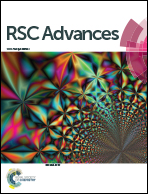Exfoliating nanomaterials in canola protein derived adhesive improves strength and water resistance†
Abstract
Wood adhesives are mainly produced using petrochemical-based resins. However, concerns over environmental and health effects have prompted a renewed interest on developing bio-based adhesives. The potential of using canola protein for adhesives was explored with limited success. Similar to other proteins, canola adhesives also have weak adhesion and water resistance. The objective of this research was to develop and characterize nanomaterial reinforced canola protein adhesive with improved water resistance and adhesion strength. Hydrophilic bentonite (bentonite), surface modified nanoclay (SM-MMT), graphite oxide (GO), and nanocrystalline cellulose (NCC) were exfoliated at different addition levels (0, 1, 3, 5, 10% w/w) using an improved solution intercalation method. A significant increase (p < 0.05) in both dry and wet adhesion was found at addition levels of 1–3% (w/w). NCC and GO showed superior effect over bentonite and SM-MMT. The improvement in adhesive strength at low nanomaterial addition was a result of adequate exfoliation of nanomaterials in protein matrix, and increased exposure of functional groups for enhanced interaction with wood surface. This study demonstrated for the first time the potential of nanomaterials for improving adhesion and water resistance of protein-derived adhesive. Canola protein adhesive developed in this study showed its potential for replacing synthetic adhesives as green alternative adhesive materials.



 Please wait while we load your content...
Please wait while we load your content...